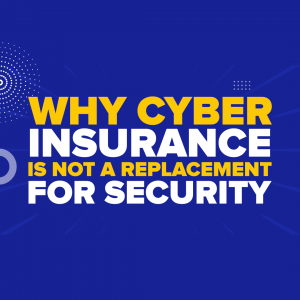 Cyber insurance has become an important part of business risk management. While it can help in case of a cyberattack, it’s essential to understand that insurance alone won’t protect your organization. In this post, we’ll explain why cyber insurance should act as a safety net rather than a replacement for a solid cybersecurity plan.
Cyber insurance has become an important part of business risk management. While it can help in case of a cyberattack, it’s essential to understand that insurance alone won’t protect your organization. In this post, we’ll explain why cyber insurance should act as a safety net rather than a replacement for a solid cybersecurity plan.
The Role of Cyber Insurance
Cyber insurance is designed to cover certain financial losses after a cyberattack. However, many businesses mistakenly believe that having a cyber insurance policy is enough to shield them from all risks. The reality is that insurance is just one piece of the puzzle, and without a strong cybersecurity foundation, the coverage may be limited.
6 Limitations of Cyber Insurance Coverage
Even with a policy in place, there are several situations where cyber insurance may not fully protect your business:
1. Business Interruption
Insurance might provide some compensation for lost productivity during a cyberattack, but it won’t cover everything. The financial losses from a disrupted business can be far greater than the payout from the policy.
2. Reputational Damage
Insurance can’t repair the loss of trust that occurs after a data breach. Regaining customer confidence requires effort, time, and strategy beyond financial compensation.
3. Evolving Cyber Threats
The cyber landscape is constantly changing. If your insurance policy doesn’t account for emerging threats, your business could be left exposed to newer attack methods that aren’t covered.
4. Social Engineering Attacks
Some cyber insurance policies do not cover losses caused by social engineering attacks like phishing. Since these tactics often rely on human error, businesses need to take additional steps to guard against them.
If you want to know how to INSTANTLY ideintify phishing scams, click here.
5. Insider Threats
Internal risks, such as breaches caused by employees, are often excluded from insurance coverage. If the source of the attack is inside your organization, your policy may not offer support.
If you want a full guide regarding insider threats, click here.
6. Nation-State Attacks
Some cyberattacks are launched by government-backed hackers. Many insurers consider these attacks as acts of war, which means your policy may not cover any damages resulting from them.
Strengthening Your Cybersecurity: Six Critical Steps
To ensure your business is protected, you need to go beyond just having cyber insurance. Implement these six steps to build a strong cybersecurity defense:
1. Train Your Employees
Your employees are often your first line of defense. Regular cybersecurity training and workshops will equip your team with the knowledge to recognize and avoid common cyber threats.
2. Implement Strong Password Policies
Requiring employees to use strong, complex passwords, along with multi-factor authentication, adds an extra layer of protection for your internal systems.
3. Regular Data Backups
Ensure that all business-critical data is backed up regularly. In the event of a ransomware attack or data breach, backups allow your business to recover quickly.
4. Keep Software Up to Date
Always update your software and security solutions to fix vulnerabilities before attackers can exploit them. Regular monitoring and patch management are essential to stay ahead of threats.
5. Invest in Network Security
A strong network security system, complete with firewalls, antivirus software, and real-time threat detection, is critical to keeping cybercriminals out of your network.
6. Conduct Regular Security Assessments
Evaluate your cybersecurity posture regularly to identify weak points. A thorough risk assessment will give you a clear blueprint for improving your defense strategy.
Building a Secure Future for Your Business
Cyber insurance is important, but it’s just one part of a larger security strategy. Combining a robust cybersecurity plan with the right insurance policy will give your business the best protection. However, we understand that managing these aspects can be overwhelming, especially while running your business. Contact us to help you assess your current IT environment and create a tailored security plan to meet your needs.
Darryl Cresswell
CEO & President
MYDWARE IT Solutions Inc.




